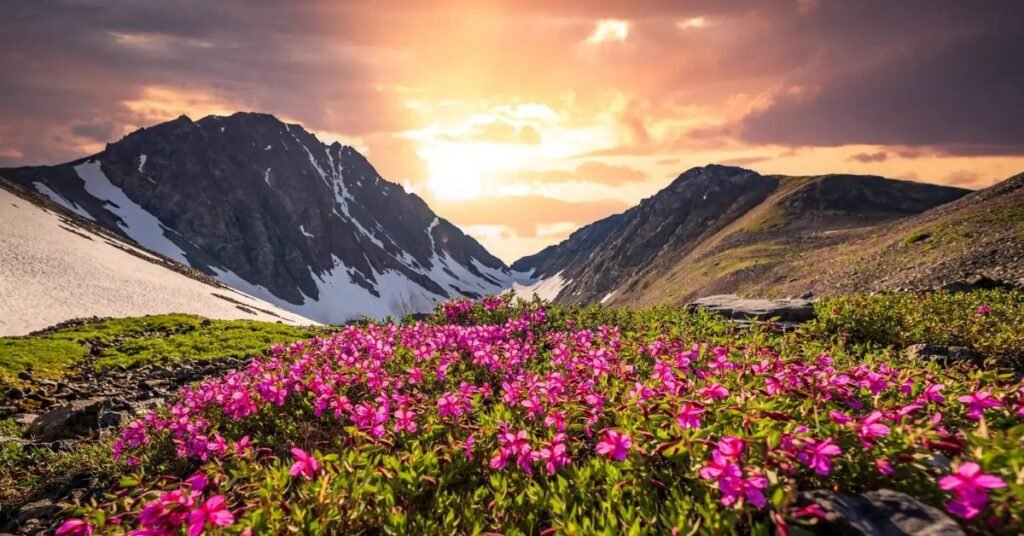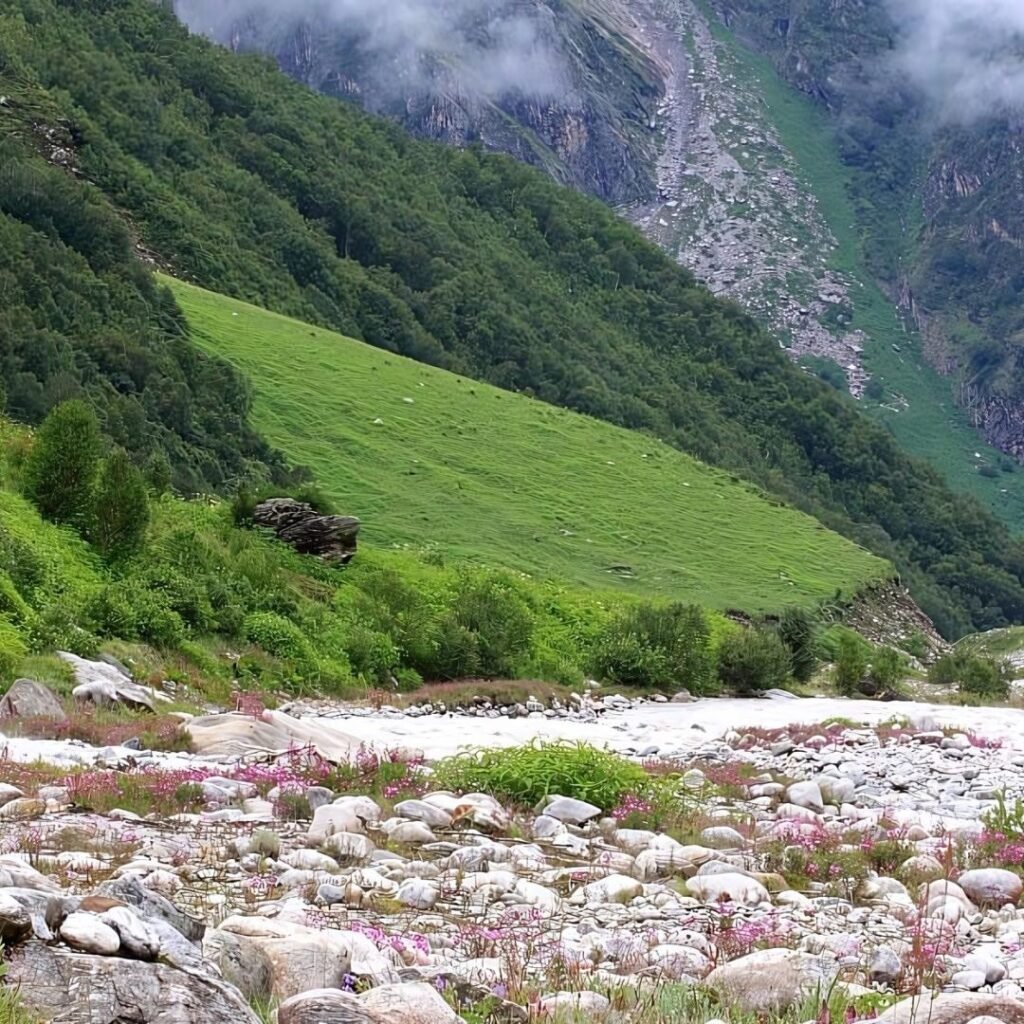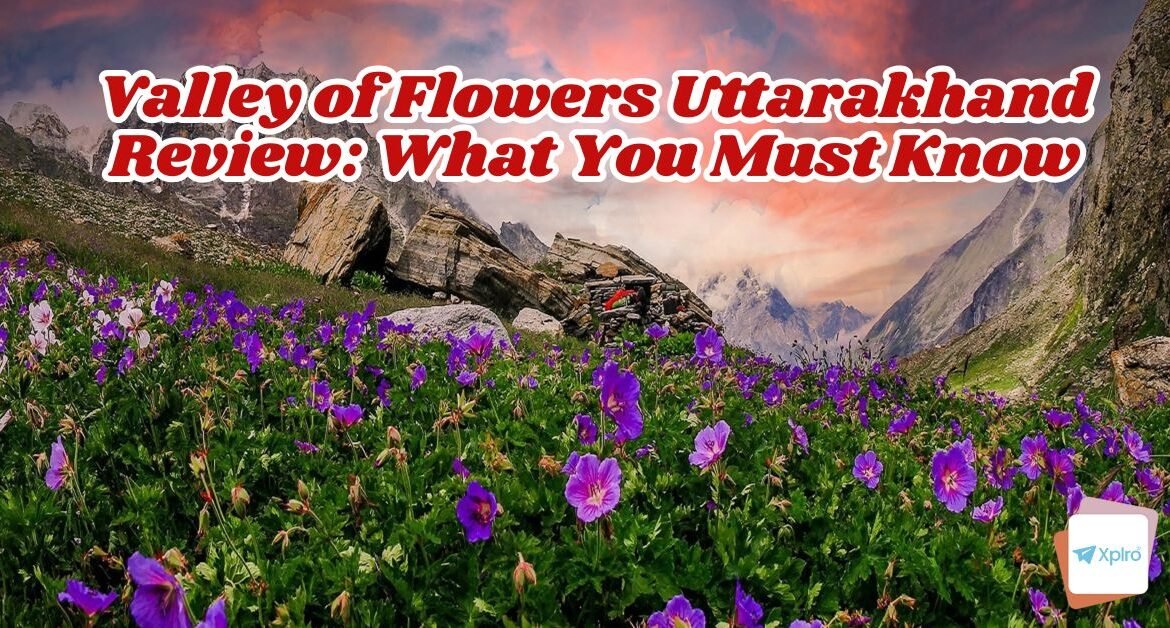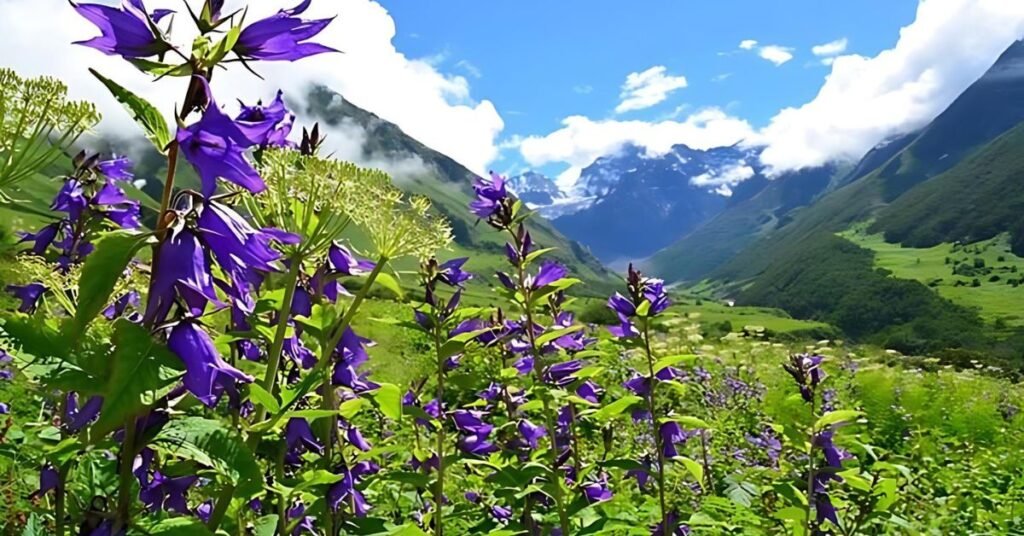Valley of Flowers Uttarakhand Review: Nestled deep in the Garhwal Himalayas, the Valley of Flowers National Park in Uttarakhand is a UNESCO World Heritage Site that feels like nature’s own canvas. Spread over 87 square kilometers and perched at an altitude of around 3,600 meters, this pristine alpine valley comes alive each monsoon with over 500 species of wildflowers, making it a visual spectacle of rare Himalayan biodiversity.
With snow-capped peaks, glacial streams, and lush alpine meadows, the Valley of Flowers is more than just a trekking destination—it’s a spiritual and ecological sanctuary that attracts nature lovers, adventure seekers, botanists, photographers, and pilgrims from across the world. Whether you’re hiking to experience the rare blue poppy, paying homage at the Hemkund Sahib Gurudwara, or simply soaking in the tranquil aura, the journey offers an unforgettable escape into the raw beauty of the Himalayas.
In this Valley of Flowers Uttarakhand review, Xplro.com dives deep into everything you need to know before planning your adventure — including trek routes, best time to visit, how to get permits, where to stay, essential packing tips, and local folklore that adds magic to the mountains. We’ll also share our personal experience from the trek, what we loved (and what was tough), and honest insights to help you decide if this Himalayan wonder is worth adding to your travel list.
- Overview: Why Visit the Valley of Flowers?
- Trekking Route & Itinerary
- Trekking Itinerary Breakdown
- Flora & Fauna: A Living Botanical Museum
- Wildlife You Might Spot
- Mythology & Cultural Significance
- Accommodation & Food
- Where to Stay in Ghangaria
- Food Tips
- What to Pack: Trekking Essentials
- Tips from Xplro.com’s Review Team
- Permit & Entry Details
- How to Reach Valley of Flowers
- Best Time to Visit: Month-by-Month Guide
- Final Verdict: Is It Worth It?
- FAQs
Overview: Why Visit the Valley of Flowers?
| Feature | Details |
|---|---|
| Location | Chamoli District, Uttarakhand |
| Altitude | 3,658 meters (12,000 ft) |
| Trek Difficulty | Moderate |
| Trek Duration | 6 Days / 5 Nights |
| Best Time to Visit | Mid-July to Mid-August |
| Entry Permit Required | Yes (from Forest Department at Ghangaria) |
| UNESCO World Heritage Site | Yes (Declared in 2005) |
The valley is open only from June to September, and during peak bloom (July–August), it transforms into a vibrant carpet of Himalayan flora — including the rare Brahma Kamal, Blue Poppy, and Cobra Lily.
Trekking Route & Itinerary
The journey begins at Govindghat, with a scenic drive to Pulna, followed by a trek to Ghangaria, the base camp for both Valley of Flowers and Hemkund Sahib.
Trekking Itinerary Breakdown
| Day | Route | Distance / Duration | Highlights |
|---|---|---|---|
| 1 | Rishikesh → Joshimath | 255 km / 10–11 hrs drive | Scenic mountain roads |
| 2 | Joshimath → Pulna → Ghangaria | 13 km trek | Riverside trail, waterfalls |
| 3 | Ghangaria → Valley of Flowers | 7.4 km round trip trek | Wildflowers, Pushpawati River |
| 4 | Ghangaria → Hemkund Sahib | 12 km round trip trek | Glacial lake, Gurudwara, spiritual vibe |
| 5 | Ghangaria → Pulna → Joshimath | 13 km trek + drive | Return journey |
| 6 | Joshimath → Rishikesh | 255 km / 9–10 hrs drive | Final descent |
Flora & Fauna: A Living Botanical Museum
The valley is home to over 500 species of flowering plants, many of which are endemic and medicinal. During peak bloom, the landscape is painted with:
- Himalayan Blue Poppy
- Brahma Kamal
- Marigolds
- Primulas
- Orchids
- Asters
- Cobra Lily
Wildlife You Might Spot
| Animal | Notes |
|---|---|
| Himalayan Monal | Uttarakhand’s state bird |
| Musk Deer | Rare and elusive |
| Snow Leopard | Extremely rare sightings |
| Black Bear | Found in higher altitudes |
Mythology & Cultural Significance
The Valley of Flowers isn’t just a trek — it’s a spiritual journey. According to legends:

Spiritual Journey to Valley of Flowers – Xplro
- Hanuman collected the Sanjeevani herb here to save Lakshman in the Ramayana.
- The valley is referred to as Nandan Kanan in ancient texts — the garden of Lord Indra.
- Nearby Hemkund Sahib is where Guru Gobind Singh is believed to have meditated in a previous life4.
Accommodation & Food
Since overnight stays are not allowed inside the park, trekkers stay at Ghangaria, a small village with basic facilities.
Where to Stay in Ghangaria
| Option | Type | Price Range (INR) | Notes |
|---|---|---|---|
| Guesthouses | Budget | ₹500–₹1,000/night | Basic amenities |
| Swiss Tents | Mid-range | ₹1,500–₹2,500/night | Cozy, with attached bathrooms |
| Hotels | Premium | ₹3,000+/night | Limited availability |
Food Tips
- Carry packed lunch for the trek days.
- Local eateries offer Maggi, parathas, tea, and basic meals.
- Langar at Hemkund Sahib is a must-experience — hot khichdi, halwa, and tea served with devotion.
What to Pack: Trekking Essentials
| Category | Items to Carry |
|---|---|
| Clothing | Waterproof jacket, thermals, quick-dry tees, gloves |
| Footwear | Trekking boots, floaters, anti-blister socks |
| Gear | 40L backpack, headlamp, trekking pole, poncho |
| Documents | ID proof, medical certificate, entry permit |
| Personal Care | Sunscreen, lip balm, toiletries, basic medicines |
Tips from Xplro.com’s Review Team
After reviewing the Valley of Flowers trek in July 2025, here are our top insights:
- Start early: The valley closes by 2 PM daily.
- Stay hydrated: Carry your own water bottles; refill at streams.
- Respect nature: Don’t pluck flowers or stray off trails.
- Prepare for rain: Monsoon showers are frequent — waterproof everything.
- Acclimatize: Ghangaria is at 10,000 ft; AMS is real.
Visual Highlights: Valley of Flowers Uttarakhand Review
While we can’t embed images here, Xplro.com’s review features stunning visuals of:

- The Pushpawati River winding through flower-laden meadows
- Blue Poppy Point — a panoramic viewpoint
- Snow-capped peaks like Gauri Parvat and Rataban
- Waterfalls and glacial streams along the trail
You can explore these visuals on Xplro.com’s official blog.
Permit & Entry Details
| Requirement | Details |
|---|---|
| Entry Permit | Issued at Forest Check Post in Ghangaria |
| Fee | ₹150 for Indians / ₹600 for foreigners |
| Timings | 7:00 AM to 2:00 PM (last entry) |
| Camping | Not allowed inside the park |
| Photography | Allowed (no drones) |
How to Reach Valley of Flowers
| Mode | Route / Details |
|---|---|
| By Air | Nearest airport: Jolly Grant, Dehradun (295 km) |
| By Train | Rishikesh Railway Station (270 km from Govindghat) |
| By Road | Delhi → Rishikesh → Joshimath → Govindghat → Pulna |
From Pulna, the trek begins. Vehicles are not allowed beyond this point.
Best Time to Visit: Month-by-Month Guide
| Month | Highlights | Crowd Level |
|---|---|---|
| June | Snow patches, early bloom | Low |
| July | Peak bloom, lush greenery | Moderate |
| August | Full bloom, vibrant colors | High |
| September | Clear skies, fewer flowers | Moderate |
Final Verdict: Is It Worth It?
The Valley of Flowers is not just a trek — it’s a symphony of nature, culture, and spirituality. Whether you’re a first-time trekker or a seasoned explorer, this journey will leave you transformed. Nestled deep in the Garhwal Himalayas of Uttarakhand, the Valley of Flowers trek takes you through a mystical land where over 500 species of wildflowers bloom in riotous color against the backdrop of snow-capped peaks. This UNESCO World Heritage Site is not only a visual paradise but also a spiritual retreat for nature lovers and adventure seekers alike.
From the moment you step into Govindghat and begin your ascent through Ghangaria, the valley reveals itself like a sacred secret — misty trails, alpine bridges, waterfalls, and meadows bursting with vibrant orchids, poppies, and blue primulas. The trek is moderate in difficulty, making it accessible to most fitness levels, and typically spans 6 days, offering a rare opportunity to disconnect from the digital world and reconnect with nature’s purest form.
Besides its floral diversity, the Valley of Flowers trek is also culturally enriching. It is closely tied to local folklore and the Sikh pilgrimage to Hemkund Sahib, which sits at 14,000 feet. Whether you’re chasing rare Himalayan blooms, seeking inner peace, or simply craving fresh mountain air, the Valley of Flowers delivers an unforgettable Himalayan experience.
So, if you’re searching for the best monsoon trek in India or a life-changing adventure in the mountains, the Valley of Flowers trek should be at the top of your list.
FAQs
1. Where is the Valley of Flowers National Park located in Uttarakhand?
- It lies in Chamoli district, within the Nanda Devi Biosphere Reserve, surrounded by the pristine Garhwal Himalayas.
2. When is the best time to visit Valley of Flowers for blooming season?
- Peak bloom occurs from mid-July to mid-August, though the valley is open between June and October.
3. What is the difficulty level of the Valley of Flowers trek?
- Classified as moderate, the trek features gradual inclines. It’s beginner-friendly with basic fitness.
4. Is a permit required for Valley of Flowers entry?
- Yes. Get it at the Ghangaria Forest Check Post. Current fees: ₹150 for Indians, ₹600 for foreigners.
5. Can tourists camp inside Valley of Flowers National Park?
- No camping allowed inside the valley. Stay overnight at Ghangaria, the base village.
6. How long is the trek from Govindghat to Valley of Flowers?
- It’s a 13.7 km trek: 10 km from Pulna to Ghangaria, then 3.7 km to the valley.
7. Is Hemkund Sahib near Valley of Flowers? Can both be visited?
- Yes, it’s nearby. Plan a separate day for Hemkund Sahib as it involves a steeper 6 km climb.
8. Which flowers bloom in the Valley of Flowers during monsoon?
- Expect Brahma Kamal, Blue Poppy, Cobra Lily, Primulas, and Orchids, among 500+ alpine varieties.
9. Are trekking guides mandatory for Valley of Flowers?
- Not compulsory, but hiring a guide helps with navigation, flora knowledge, and safety.
10. Is it safe to trek Valley of Flowers solo?
- Yes, it’s generally safe. Start early, inform someone of your itinerary, and stay alert.
11. What wildlife can be seen in Valley of Flowers Uttarakhand?
- Sightings include Himalayan Monal, Musk Deer, Black Bear, and rare glimpses of Snow Leopard.
12. Is mobile network available in Valley of Flowers or Ghangaria?
- Ghangaria has limited coverage. The valley itself is a no-network zone, ensuring digital detox.
13. What essential items should I pack for the Valley of Flowers trek?
- Carry waterproof shoes, rain gear, medications, warm layers, ID proof, and energy snacks.
14. Are public restrooms available near the Valley of Flowers trek?
- Basic facilities only at Ghangaria. Inside the valley, there are no restrooms.
15. Can Hemkund Sahib and Valley of Flowers be explored in one day?
- Highly discouraged. Both require individual trekking days due to elevation and effort.
16. Is Valley of Flowers open in the winter months?
- No. It remains closed from November to May due to snowfall and treacherous conditions.
17. How to reach Valley of Flowers from Delhi?
- Take this route: Delhi → Rishikesh → Joshimath → Govindghat → Pulna → Ghangaria → Valley of Flowers.
18. Are food and stay options available in Ghangaria?
- Yes. Ghangaria has budget lodges and small eateries serving Maggi, tea, thalis, and essentials.
19. Is Valley of Flowers trek suitable for children or elderly tourists?
- Children above 10 can attempt with caution. Elders may hire ponies or palanquins for the trek.
20. Why is Valley of Flowers considered a UNESCO World Heritage Site?
- It’s globally recognized for its exceptional alpine flora, rare biodiversity, and spiritual aura.





